CHARLOTTE, N.C. — Flooded homeowners who live above and below Lake Norman are convinced Duke Energy's decisions before and during Hurricane Helene protected that lake at the expense of those upstream and downstream.
"Duke Energy fell asleep at the wheel," Betsy Patton said. "Actually, they didn't fall asleep. They were wide awake. They didn't do what they should have done."
Patton lives along the Catawba River in Charlotte, below Mountain Island Lake, where floodwaters rushed over the spillway and washed away the four houses that once stood next door.
"Never ever have four houses slammed into my house," Patton said. "I Know it was biblical proportions. I get it, it's a lot to manage, but they could have done it."


Meanwhile, along Lookout Shoals in Claremont, Eric Bauchwitz shares similar anger.
"This was a lot of water heading our way. They knew it," he said. "It feels like we're taking the brunt because these homes aren't worth as much as Lake Norman."
In an Oct. 2 filing to the Federal Energy Regulatory Commission, Duke Energy said the flooding at Lookout Shoals and Mountain Island Lake and along the Catawba River was unpreventable, citing the small size of the lakes coupled with "the historic amount of rainfall."
Lake Norman sits between the two lakes. During Helene, Duke Energy records show the water at the lakes directly above and below Norman, places where the median household incomes are much lower, increased well above their licensed maximum levels. Both Lookout Shoals Lake and Mountain Island Lakes increased by roughly 12 feet, according to the utility's FERC filing. The much larger Lake Norman, which barely and only briefly crested above its maximum, rose only about three feet, Duke Energy data reveals.

Duke Energy has said the utility started moving water through its 11-lake system on the Tuesday before Helene hit, but won't release specifics to WCNC Charlotte. A spokesperson said Duke Energy will provide "any required notifications and requested information" to FERC.
"Lakes are managed as an integrated system, not for the benefit of a single lake ..." Duke Energy spokesperson Ben Williamson said in a statement Monday. "... This storm will likely prove to be the flood of record for much of the Catawba-Wateree River Basin above Mountain Island Lake, including Lookout Shoals Lake. Lake Norman is nearly 30 times larger than Lookout Shoals Lake and about 10 times larger than Mountain Island Lake. Duke Energy operated its lakes, including Lake Norman, to reduce the impacts of flooding for lake and river neighbors upstream and downstream prior to, during and after the storm."

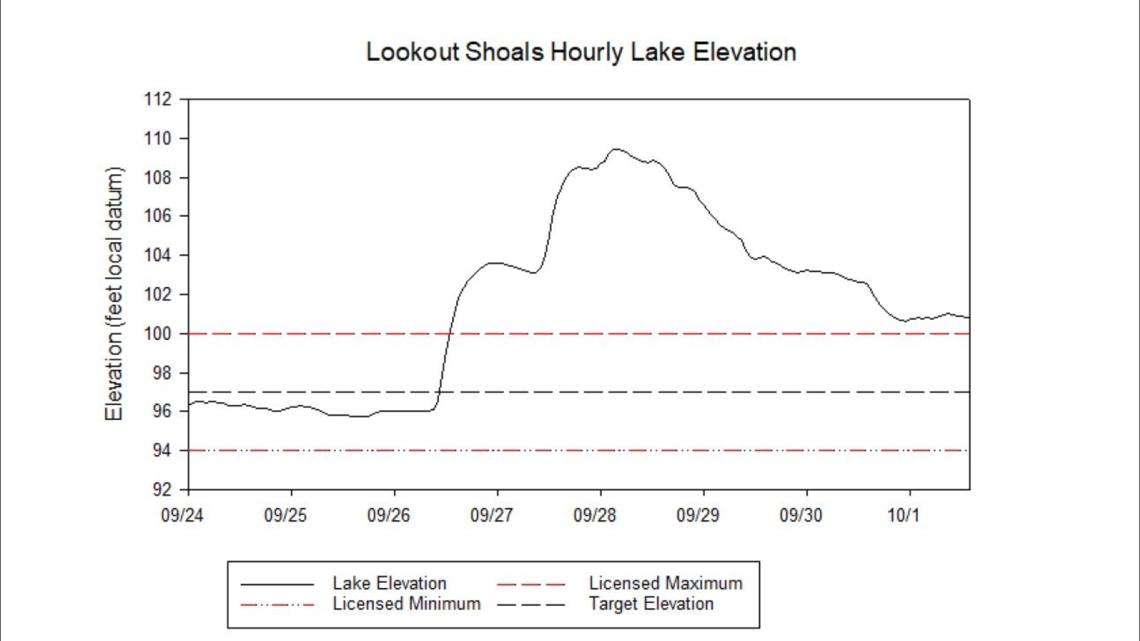

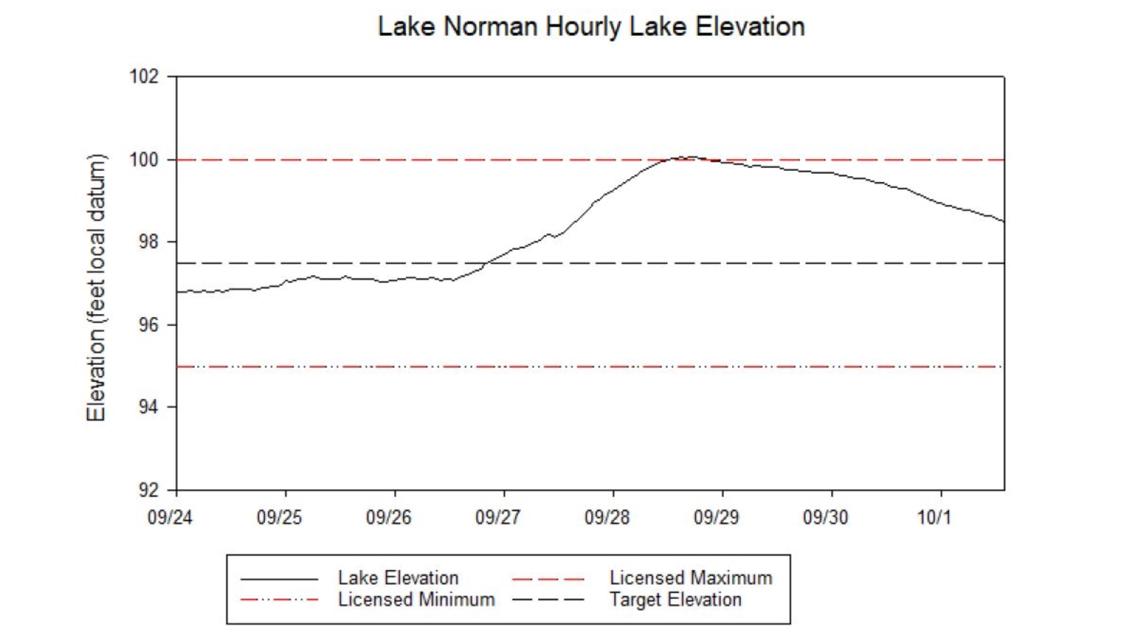

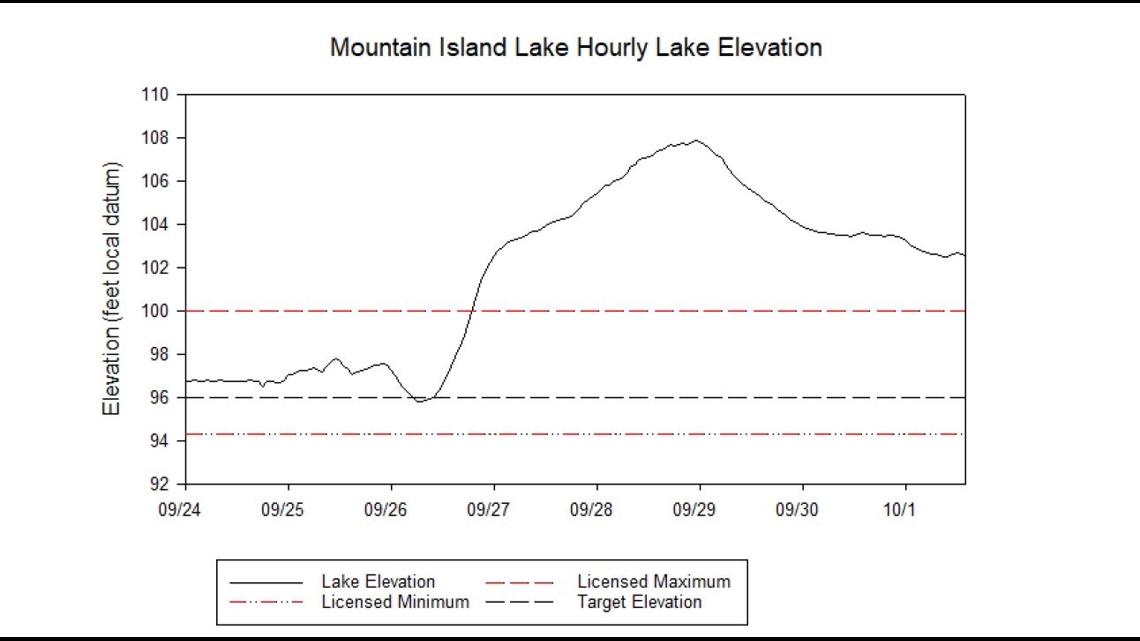
In the days after flooding forced people out of their homes, a Lake Drive resident called Duke Energy "an active accomplice" of this "act of God." Several flood victims sued the utility after a 2019 flood, alleging negligence, among other things. The lawsuit, which resulted in a settlement "that was satisfactory to both parties," accused Duke Energy then of failing "to lower dam levels to accommodate the expected heavy rainfall," in part.
Following that flood, public records show the FERC required Duke Energy to complete an after-action evaluation. As a result, the utility added additional stream gages to monitor tributaries upstream, bought weather radios for distribution and created a smartphone app for people to better monitor lake levels, among other things, according to an April 2020 FERC filing.
"Our hearts go out to the communities and lake and river residents affected by this historic rain event," Williamson added in his statement. "Duke Energy is confident that our hydro operations team managed this event as effectively as possible to help mitigate flooding impacts for all lake and river neighbors and the public along the 11 lakes of the Catawba-Wateree River."
Duke Energy's statement does not explicitly address the risk of dam failure at Cowans Ford, but WCNC Charlotte's Brad Panovich previously explained why Lake Norman never rises much above its maximum.
"If the lake overflows, it literally goes over the dam and can cause the dam to possibly fail," he said in a Sept. 28 Facebook post. "Also...right next to the dam just so happens to be the McGuire Nuclear Station. Which would flood or be damaged as well. So Lake Norman is always kept just below flood stage for this reason. All historic crests are right around 100. So be mad, but I understand that not losing all our power generation for Charlotte, having a radioactive disaster, and a massive flash flood of all of Lake Norman all at once is something we should probably avoid."
Full Duke Energy statement:
"Lakes are managed as an integrated system, not for the benefit of a single lake. Differences from lake to lake arise from lake-specific factors, for example, a gated versus ungated spillways, location/amount of the rainfall, storage capacity of the lake and shoreline topography. For example, Lake Norman has a gated spillway while Lookout Shoals and Mountain Island Lake have ungated spillways. When storms cause lakes to reach their maximum capacity (full pond), the excess storm flow must move through the spillways. For dams with ungated spillways (like Lookout Shoals and Mountain Island), the lake rises above full pond and flows over the spillway to move water. For dams with gated spillways (like Lake Norman and Lake Hickory), the spillway gates must be raised to move the excess flow.
As mentioned, this storm was historic and the rain amount for the Catawba-Wateree River Basin far exceeded national and global forecasts. Forecasting actual inflow from an approaching storm is a complex and inexact science. Duke Energy must balance preparatory drawdowns with the possibility the storm will miss the river basin to avoid an unintentional drinking water shortage, particularly if drought conditions occur. The lakes also provide water for industrial uses, power generation and recreation.
All of our lakes were at or below target levels before inflows from Hurricane Helene reached our reservoirs. The data provided on the Duke Energy Lakes website provides a daily average and does not represent an hour-by-hour lake level.
The size of Lake Norman makes it extremely difficult to lower the reservoir quickly, and any water that is moved through Lake Norman must flow into Mountain Island Lake. As shared with you before, Mountain Island Lake is a significantly smaller reservoir and has smaller powerhouse capacity (running one hydro unit at Cowans Ford is approximately equal in flow to running all four hydro units at Mountain Island), and therefore, further reduces the rate at which Lake Norman can be lowered without spilling at Mountain Island Lake. This storm will likely prove to be the flood of record for much of the Catawba-Wateree River Basin above Mountain Island Lake, including Lookout Shoals Lake. Lake Norman is nearly 30 times larger than Lookout Shoals Lake and about 10 times larger than Mountain Island Lake. Duke Energy operated its lakes, including Lake Norman, to reduce the impacts of flooding for lake and river neighbors upstream and downstream prior to, during and after the storm.
Our hearts go out to the communities and lake and river residents affected by this historic rain event. Duke Energy is confident that our hydro operations team managed this event as effectively as possible to help mitigate flooding impacts for all lake and river neighbors and the public along the 11 lakes of the Catawba-Wateree River."
Contact Nate Morabito at nmorabito@wcnc.com and follow him on Facebook, X and Instagram.

